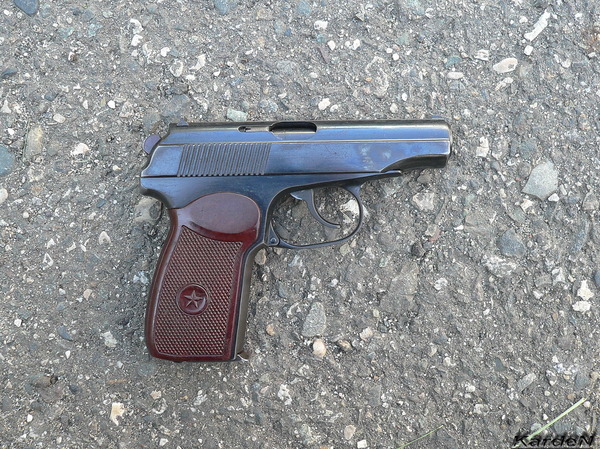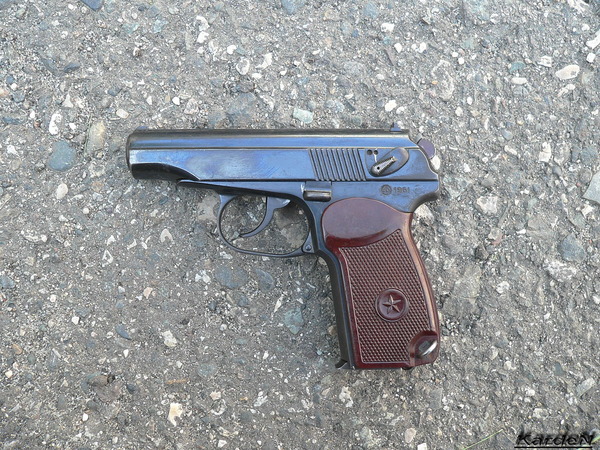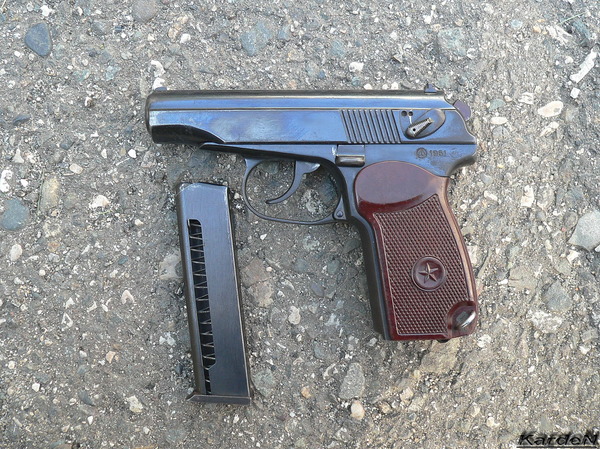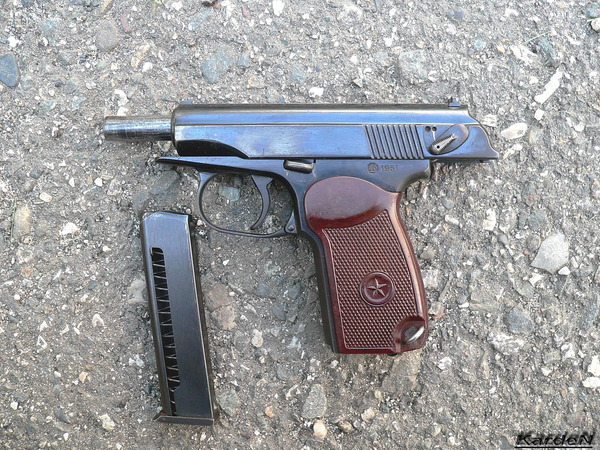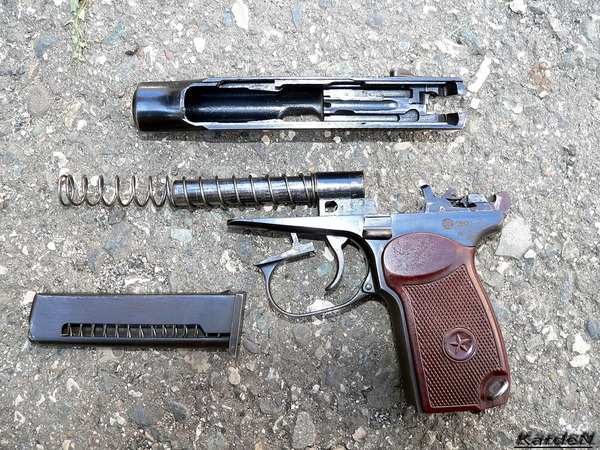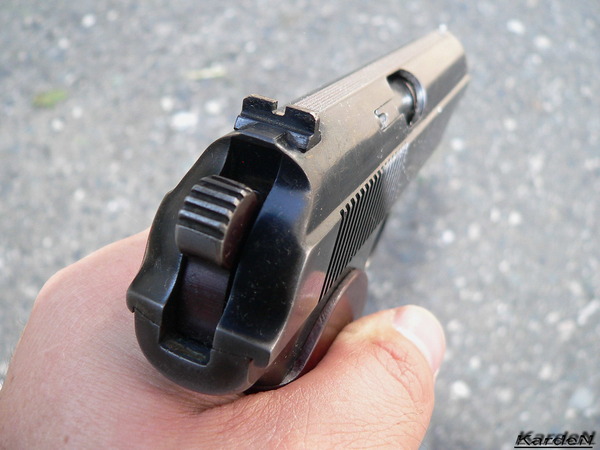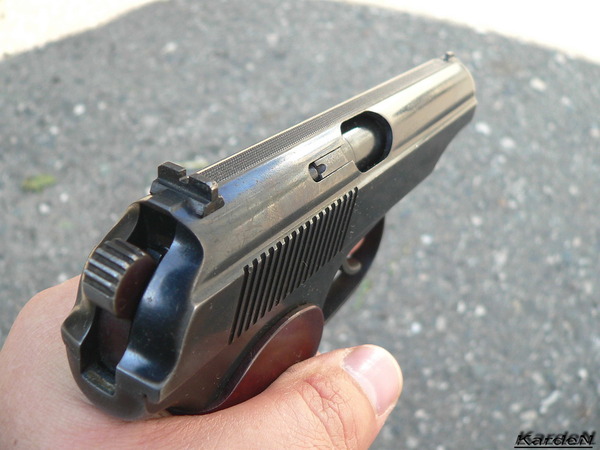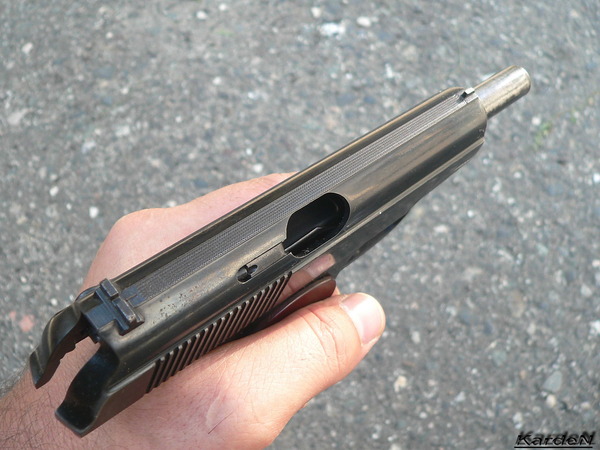PM Makarov pistol
|
Specifications PM Caliber...........................................................9 mm Cartridge ..................................................9x18 PM Weight w/o cartridges................................0.73 kg Length.........................................................161 m Length of barrel .......................................93.5 mm Bullet muzzle velocity..............................315 m/sec Effective rate of fire ...............................30 rds/min Sighting range................................................50 m Magazine capacity...........................................8 rds
|
|
In 1945 the USSR announced a tender for a new pistol intended to replace the 7.62 mm Tokarev TT pistol. Experience, gained in the course of the Great Patriotic War, demanded a significant revision of requirements to small arms as a whole, and side arms in particular. The intention was to develop a compact pistol. Although, pistols were still required to have an effective range of fire of up to 50 m, side arms were more frequently used at to 25 m. Besides the accuracy of fire, other important factors include the stopping power of the bullet, the speed of firing the first shot (double-action mode), failure-free operation (simple design), and safe handling (introduction of a manual safety catch).
The Small Arms Directorate of the Main Artillery Directorate tasked to develop a more compact and lighter pistol offering the same bullet stopping power as the TT pistol does. At the same time specification requirements included the calibers of 7.62 mm (the 7.62x25 TT cartridge), 7.65 mm (7.65x17 Browning cartridge), and 9 mm (future 9x18 cartridge). The tender saw participation of F. V. Tokarev, P. V. Voevodin. S .A. Korovin. I. I. Rakov, S. G. Simonov, N. F. Makarov, G. V. Sevryugin, A. A. Klimov, and A. I. Lobanov. N. F. Makarov of the Tula-based TsKB-14 Central Design Bureau presented the 7.65 mm TKB-412 pistol prototype designed to fire the Browning cartridge and the 9 mm TKB-429 prototype chambered for the new 9 mm cartridge. The 9 mm version, designated the 9 mm Makarov PM pistol Mod 1951, entered the inventory in 1951 and was put into production at the Izhevsk Mechanical Plant in 1953.
As production process improved, BMZ designers and production engineers heavily contributed to higher operational reliability and maintainability of the pistol. They introduced a chrome-plated bore, replaced milling of forged steel parts with casting and subsequent milling — for instance, steel casting was introduced for manufacturing the sear, the safety catch, the hammer, and the trigger. The machine-cut laminated fabric grip was replaced with a pressed one. In the late 1980s the major pistol parts (frame and slide) came to me manufactured by precision investment casting. A high operational reliability level has been achieved over the pistol production period. The Makarov PM pistol became one of the world's most popular and most reliable pistols in the late XX century.
The pistol is a blowback-operated weapon. The slide fully wraps the barrel. The barrel is pressed into the frame and secured by a lock pin. The recoil spring is wound directly around the barrel- The slide moves along the guide tracks of the frame, and the reduced contact area of the rubbing parts facilitated better reliability of the mechanism. The cartridge extractor is mounted openly in the ejection port of the slide
The pistol is fitted with an external-hammer trigger assembly. The firing pin is mounted inside the slide. The hammer, pivoted to the frame, has a cocked position and a half-cock The V-type leaf hammer spring is accommodated inside the grip. The wide branch of the hammer spring engages the hammer, while its narrow branch springs the cocking lever and the trigger bar. The lower curve of the hammer spring acts as the magazine lock. The cocking lever on the trigger bar also acts as a disconnector The trigger is pulled with a warning, s. e. after a preliminary free travel of the trigger the shooter feels a stop, after which only a slight effort is required to fire the pistol.
A sustained pull on the trigger moves the trigger bar forward. The cocking lever is pivoted to enter a notch in the hammer, and the further movement of the trigger bar forces the cocking lever round to rotate the hammer back. This movement continues until the cocking lever slips out of the notch in the hammer, taking the sear with it. The hammer is then free to go forward and drive the firing pin forward to fire the cap. The pistol fires a shot. The spend cartridge case, forced by the chamber pressure, moves backward tanking the slide with it. The slide simultaneously rotates the hammer backward and compresses the recoil spring. The recoiling slide forces the cocking lever sideways, dear of the sear. The sear is then impelled against the hammer by its spring. As the hammer is rocked back by the slide, the sear engages and holds the hammer notch. The spent cartridge case hits the cartridge ejector and is extracted through the ejection port. The protruding upper end of the trigger guard limits the backward movement of the slide. When the slide runs out the hammer remains held back. The slide, forced by the recoil spring, completes its forward movement, chambering the next round, and closing the breech. But the trigger is still pressed and must be released. If the slide does not complete its forward movement, the cocking lever will not move into a corresponding notch of the sear, and no shot will be fired.
In the double-action mode the hammer is cocked by the cocking lever, engaging a corresponding hammer tooth. Since the rotating cocking lever Sifts the sear with its, upper end, the hammer does not slide into the sear notch, but releases the self-cocking lever tooth and strikes the firing pin.
The manual safety lever, mounted on the slide, blocks the hammer and the slide (locking the slide and the frame). After chambering a round, the safety catch can be rotated to the 'safe' position (the hammer moves to the half-cock position), and the pistol can be holstered while being ready for action.
Replacement of a number of pins with pivot bolts, and the cylindrical spiral hammer spring with a leaf one made the pistol manufacture, disassembly and assembly easier as compared to its German Walther PR prototype. Another significant difference from the Walther PP pistol consists in the fact that the PM safety lever rotates downwards to the lire position, which is more natural and convenient than the upwards-moving safety of the Walther.
The pistol is fed from a single-column eight-cartridge magazine, inserted into the pistol grip. When the magazine is empty, the magazine follower lofts the slide stop and the slide remains to the rear. The protruding part of the slide stop acts as the cartridge ejector. The slide can be released by depressing the slide stop latch.
The fixed foresight and rear sight are mounted on the slide.
Plastic wrap-around grip plates are a single part, screwed to the frame with a single screw. The left-hand grip is fitted with a flush-mounted bracket for the safety strap.
The pistol features a simple and efficient design, a handy shape. It is easy to handle and features small dimensions and weight, and an outstanding reliability.
The Makarov PM pistol was fielded with all services and branches of the Armed Forces with no modifications. It entered the inventory of 12 foreign states, including former Warsaw Pact member-states, China and certain developing countries. Besides Russia the PM pistol was also manufactured in Bulgaria, North Korea, China and East Germany.
A 9 mm pistol cartridge, developed by B. V. Semin and N. M. Elizarov from the NII-44 Research Institute, was fielded in 1951 together with the PM pistol. Initially, the 9x18 PM cartridge featured a lead-cored bullet and a bimetal jacket. A cheaper steel-cored lead-jacket bullet (Pst) was developed in 1954, and the new cartridge was designated 57-N-181S. V. V. Trunov and P. F. Sazonov developed a tracer pistol bullet as well.
Aside from the Armed Forces, the Makarov PM pistol also entered service with law-enforcement agencies. With time, this required the development of corresponding ammunition. For instance, designers developed a 9x18 cartridge with an expanding hollow-point bullet boasting greater stopping power The SP-7 hollow-point bullet with a polyethylene nose plug and an increased muzzle velocity is designed to kill enemy manpower. The SP-8 light low-velocity bullet is designed to inflict minimum damage to soft obstacles which is required, for instance, when using the weapon aboard aircraft.
A bullet of the organic 57-N-181S round can be stopped by Class 1 body armor, and Class II (IIA) bullet-proof glass. Thus, as early as the 1970s the USSR State Security Committee (KGB) tasked to develop the RG028 cartridge, designed to defeat Class 2 body armor when fired from the PM or the PB silent pistol. The cartridge, developed by TsniiTochMash, penetrated a 4 mm titanium plate of the ZhZT-71M body armor.
In 1996 the Tula-based Sporting and Hunting Guns Central Research and Design Bureau (TsKIB SOO) developed the OTs-15 Lin device for the Russian Ministry of Interior The device was designed lo throw a thin line to a roof or over an obstacle by firing a shot from the PM pistol.
Although new combat pistol systems became available, it is obvious that the Makarov PM pistol will remain in service for years to come. In this context, in 1997 the Tula-based KBP Instrument Design Bureau started working on an enhanced-penetration cartridge for organic PM pistols. The cartridge was designated 7N25 and fielded in 2005. The new bullet is capable of penetrating Class 2 body armor at a range of 10 m.
The Makarov pistol has become the basis for "commercial." "service." and civilian models. For instance, in the 1990s the Izhevsk Mechanical Plan! manufactured iZh-790, IZh-70-17A (IZh-70-200) and IZh-70KhTs (IZh-70-100) exports versions.
The IZh-71 'service' modelis chambered for the 9x17 mm short (0.380 ACP) cartridge. There are also gas variants of the Makarov PM, for instance, the IZh-79 (6P42) chambered for 7.62 mm, 8 mm and 9 mm gas cartridges. The 9 mm SZh-79-9T non-lethal pistol, firing rubber bullets, made sis appearance in the market in 2004. The IZh-79-9T, produced in Izhevsk and nicknamed 'Makarych', and the MP-654K gas-cylinder airgun pistol (where MP stands for 'Mechanical Plant') have become quite popular in the civilian market.
|
||||||||
|
|
||||||||
| All photos Makarov pistol - PM >> |



